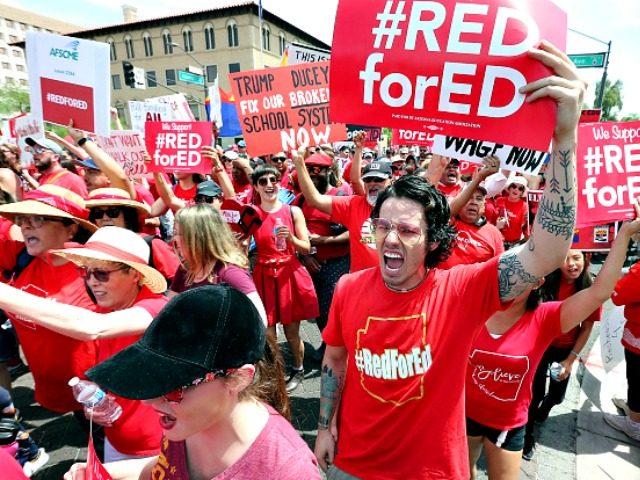The #RedforEd movement unveiled a new tactic in Wake County, North Carolina last week: lobbying for significant increases in local property taxes to fund higher teachers salaries and spending on public education.
Wake County has a population of one million, and includes all of the city of Durham and most of the city of Raleigh.
“Wake County Manager David Ellis presented his 2020 budget recommendation to the Wake County Board of Commissioners Monday night that would include a nearly 10 percent property tax increase,” WRAL reported earlier this month.
As ABC 11 reported, a contentious Wake County Commission meeting was held last week where that proposal was up for public discussion:
Some taxpayers who opposed to the tax increase shouted and hoisted signs reading “No Tax Hike” and ‘”Cut Costs First.”
On the other side of the room sat a large number of Wake County parents and teachers, wearing red for education, loudly applauding each speaker who spoke in favor of fully funding Wake schools’ $48.9 million budget request.
As it stands now, Wake County Manager David Ellis is proposing to give WCPSS $36.5 million in additional funding in FY 2020.
The North Carolina #RedforEd group, which along with the North Carolina Association of Educators sponsored the May 1 rally at the State Capitol in Raleigh which drew 15,000 teachers who walked out of classes to lobby for more state money, has not formally taken a stance on the Wake County local property tax increase, but the crowd was comprised of a number of Wake County #RedforEd members, as ABC’s Joel Brown noted in this tweet:
“It is a joy to spend a little more to know that we will have better schools.” —
Wake teachers wearing #RedForEd along with many parents are here pushing Wake commissioners to fully fund #WCPSS budget request. #abc11 #nced pic.twitter.com/sT8o43iUX7— Joel Brown (@JoelBrownABC11) May 20, 2019
As Breitbart News reported in February:
This teachers union effort, called #RedforEd, has its roots in the very same socialism that President Trump vowed in his 2019 State of the Union address to stop, and it began in its current form in early 2018 in a far-flung corner of the country before spreading nationally. Its stated goals–higher teacher pay and better education conditions–are overshadowed by a more malevolent political agenda: a leftist Democrat uprising designed to flip purple or red states to blue, using the might of a significant part of the education system as its lever
State governments provide about 49 percent of public school funding, local governments provide about 43 percent, and the federal government provides about 8 percent. Until now, applying political pressure to local school boards has been a secondary, sporadically used and informal tactic by the #RedforEd movement, which has focused most of its organizational efforts on lobbying state legislatures for more state funding of education.
But now, as many state legislatures are ending their legislative sessions, and local school boards and county boards are beginning to decide on local budgets, additional local lobbying efforts similar to the one seen last week in Wake County, North Carolina are anticipated around the country.

COMMENTS
Please let us know if you're having issues with commenting.